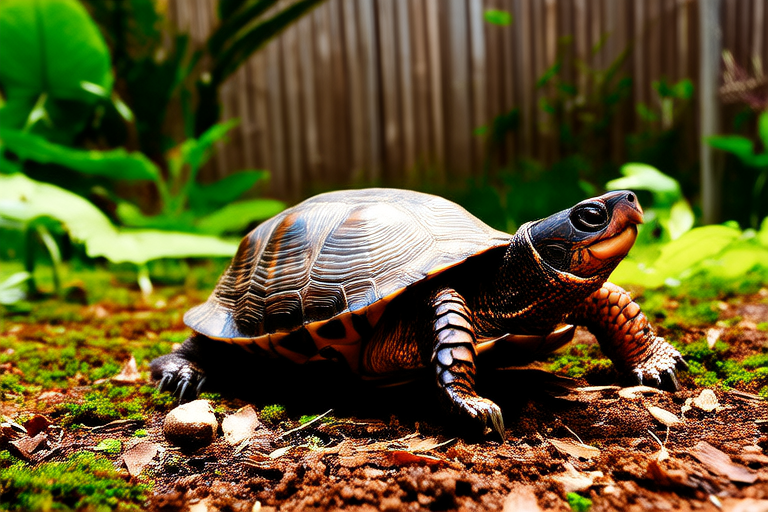How to Create the Perfect Habitat for Your Three-Striped Box Turtle
The three-striped box turtle (Terrapene triunguis) is a popular choice among turtle enthusiasts due to its hardiness and relatively small size. Providing the perfect habitat for your three-striped box turtle involves understanding its natural environment and replicating it as closely as possible. This guide will walk you through the essential elements needed to create a healthy and thriving environment for your pet.
Understanding the Natural Habitat
Native to the central United States, three-striped box turtles inhabit a variety of environments including woodlands, meadows, and grasslands. They are primarily terrestrial, spending most of their time on land but also enjoying access to shallow water for soaking and cooling off. Mimicking these conditions is crucial for their health and well-being.
Suitable Habitat Size
The enclosure size is one of the most critical factors in creating a suitable habitat. For a single adult three-striped box turtle, a minimum of 4 square feet (0.37 square meters) of floor space is recommended. Larger enclosures are always better, especially if you plan to house multiple turtles or provide more enrichment opportunities. A larger space allows for more natural behaviors and reduces stress.
Ideal Substrate Options
Selecting the right substrate is important for your turtle’s health. Suitable substrates include:
- Outdoor soil: Provides a natural environment and encourages digging behavior.
- Cedar shavings: Absorbent and can help maintain humidity levels.
- Cypress mulch: Another absorbent option that mimics the turtle’s natural forest floor.
- Newspaper or paper towels: Simple and easy to clean, though less natural.
Avoid using gravel, sand, or cat litter as they pose choking hazards and can cause impaction if ingested.
Appropriate Lighting and Temperature Requirements
Three-striped box turtles require specific lighting to regulate their body temperature and metabolism. Proper lighting includes:
- UVB light: Essential for calcium absorption and overall health. Use a UVB lamp designed for reptiles with a 10% UVB output.
- Basking light: A heat lamp should be provided to create a basking spot that reaches approximately 90°F (32°C).
Temperature gradients within the enclosure are vital; one end should be cooler (around 75°F or 24°C) while the other should offer the warmer basking spot. Ensure the temperature does not drop below 65°F (18°C) at night.
Humidity Levels
Maintaining proper humidity levels is crucial for your turtle’s respiratory health and skin condition. Aim for an ambient humidity level between 60% and 80%. You can achieve this by misting the enclosure daily or using a humidifier. Ensure there is good air circulation to prevent mold growth.
Hiding Spots
Providing hiding spots is essential for your turtle’s psychological well-being. Hides should be dark and snug, allowing your turtle to retreat when feeling stressed or needing privacy. Examples include:
- Commercial reptile hides.
- Inverted plant pots with entrance holes.
- Natural elements like hollow logs or rocks.
Water Area Specifications
A shallow water area is necessary for soaking and drinking. The water depth should not exceed the turtle’s shoulder height. Clean the water regularly and change it every few days to prevent bacterial growth. Use a water filtration system if necessary.
Diet Considerations
Three-striped box turtles are omnivorous, requiring a balanced diet of both animal and plant matter. Their diet should include:
- Insects: Crickets, mealworms, and earthworms.
- Vegetables: Leafy greens, carrots, and squash.
- Fruits: Berries, melons, and apples.
- Calcium supplements: To support bone health.
Vary the diet to ensure nutritional balance and prevent boredom. Feed your turtle daily, adjusting portions based on age and activity level.
Safety Measures
To ensure your turtle’s safety, avoid placing sharp objects or toxic plants within the enclosure. Secure the enclosure to prevent escapes and protect against predators. Regularly inspect the habitat for any signs of wear or damage that could harm your turtle.
Common Mistakes to Avoid
Many pet owners make mistakes when setting up their turtle’s habitat. Some common errors include:
- Not providing enough space.
- Using inappropriate substrates.
- Incorrect lighting and temperature settings.
- Ignoring humidity levels.
- Lack of hiding spots or water areas.
By being aware of these pitfalls, you can create a healthier and happier environment for your three-striped box turtle.
Ongoing Maintenance and Care
Regular maintenance is key to keeping your turtle’s habitat clean and safe. Here are some actionable tips:
- Spot cleaning: Remove waste and uneaten food daily.
- Deep cleaning: Clean the entire enclosure and replace substrate every 1-2 months.
- Check equipment: Inspect heating lamps, UVB bulbs, and water filters regularly for proper functioning.
- Monitor health: Watch for signs of illness or injury and consult a veterinarian if necessary.
Creating the perfect habitat for your three-striped box turtle requires attention to detail and commitment to their well-being. By following these guidelines, you can provide a nurturing environment that closely mimics their natural habitat, ensuring your turtle lives a long and healthy life.
